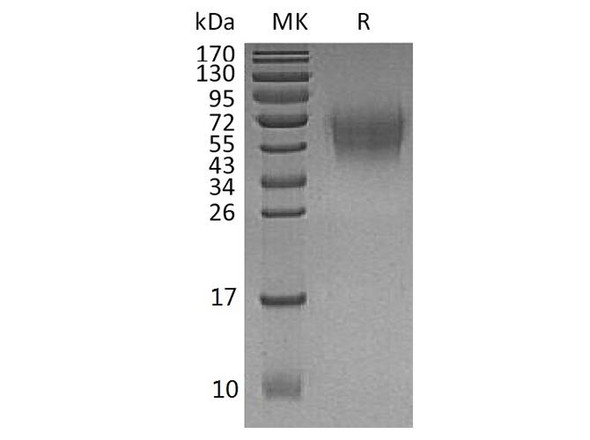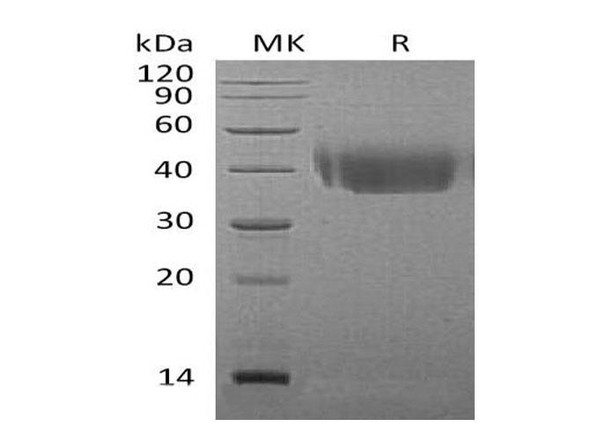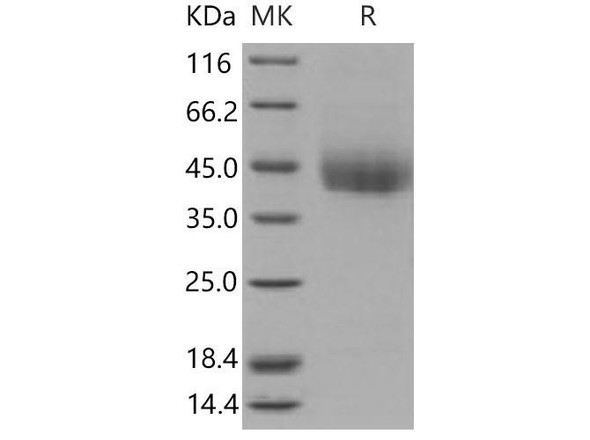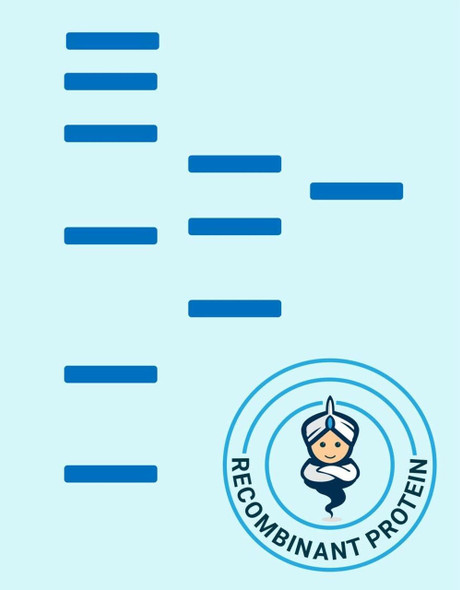Human CD226 Recombinant Protein (RPPB3043)
- SKU:
- RPPB3043
- Product Type:
- Recombinant Protein
- Species:
- Human
- Uniprot:
- Q15762
- Research Area:
- CD Antigens
Description
| Product Name: | Human CD226 Recombinant Protein |
| Product Code: | RPPB3043 |
| Size: | 20µg |
| Species: | Human |
| Target: | CD226 |
| Synonyms: | DNAM-1, PTA1, TLiSA1, CD226 antigen, DNAX accessory molecule 1, DNAM1, Recombinant Human CD226. |
| Source: | Escherichia Coli |
| Physical Appearance: | Sterile Filtered colorless solution. |
| Formulation: | CD226 protein solution (1mg/ml) containing 20mM Tris-HCl buffer (pH 8.0), 0.4M UREA and 10% glycerol. |
| Stability: | Store at 4°C if entire vial will be used within 2-4 weeks. Store, frozen at -20°C for longer periods of time. For long term storage it is recommended to add a carrier protein (0.1% HSA or BSA).Avoid multiple freeze-thaw cycles. |
| Purity: | Greater than 90% as determined by SDS-PAGE. |
| Amino Acid Sequence: | MGSSHHHHHH SSGLVPRGSH MGSEEVLWHT SVPFAENMSL ECVYPSMGIL TQVEWFKIGT QQDSIAIFSP THGMVIRKPY AERVYFLNST MASNNMTLFF RNASEDDVGY YSCSLYTYPQ GTWQKVIQVV QSDSFEAAVP SNSHIVSEPG KNVTLTCQPQ MTWPVQAVRW EKIQPRQIDL LTYCNLVHGR NFTSKFPRQI VSNCSHGRWS VIVIPDVTVS DSGLYRCYLQ ASAGENETFV MRLTVAEGKT DNQYTLFVA |
CD226 belongs to the Ig-superfamily containing 2 Ig-like domains of the V-set. CD226 is a 65kDa glycoprotein expressed on the surface NK cells, platelets, monocytes and a subset of T cells. CD226 facilitates cellular adhesion of platelets and megakaryocytic cells to vascular endothelial cells. CD226 also plays a role in megakaryocytic cell maturation.
CD226 Human Recombinant produced in E.Coli is a single, non-glycosylated polypeptide chain containing 259 amino acids (19-254a.a.) and having a molecular mass of 29.4kDa.CD226 is fused to a 23 amino acid His-tag at N-terminus & purified by proprietary chromatographic techniques.
| UniProt Protein Function: | DNAM-1: Receptor involved in intercellular adhesion, lymphocyte signaling, cytotoxicity and lymphokine secretion mediated by cytotoxic T-lymphocyte (CTL) and NK cell. |
| UniProt Protein Details: | Protein type:Membrane protein, integral; Immunoglobulin superfamily; Cell adhesion Chromosomal Location of Human Ortholog: 18q22.3 Cellular Component: cell surface; integral to plasma membrane; plasma membrane; external side of plasma membrane; lipid raft Molecular Function:integrin binding; protein binding; cell adhesion molecule binding; protein kinase binding Biological Process: regulation of immune response; positive regulation of natural killer cell mediated cytotoxicity directed against tumor cell target; positive regulation of immunoglobulin mediated immune response; cytokine production; cell recognition; positive regulation of natural killer cell mediated cytotoxicity; cell adhesion; signal transduction; positive regulation of mast cell activation |
| NCBI Summary: | This gene encodes a glycoprotein expressed on the surface of NK cells, platelets, monocytes and a subset of T cells. It is a member of the Ig-superfamily containing 2 Ig-like domains of the V-set. The protein mediates cellular adhesion of platelets and megakaryocytic cells to vascular endothelial cells. The protein also plays a role in megakaryocytic cell maturation. [provided by RefSeq, Jul 2008] |
| UniProt Code: | Q15762 |
| NCBI GenInfo Identifier: | 317373338 |
| NCBI Gene ID: | 10666 |
| NCBI Accession: | Q15762.2 |
| UniProt Secondary Accession: | Q15762,B2R818, |
| UniProt Related Accession: | Q15762 |
| Molecular Weight: | |
| NCBI Full Name: | CD226 antigen |
| NCBI Synonym Full Names: | CD226 molecule |
| NCBI Official Symbol: | CD226�� |
| NCBI Official Synonym Symbols: | PTA1; DNAM1; DNAM-1; TLiSA1�� |
| NCBI Protein Information: | CD226 antigen; adhesion glycoprotein; DNAX accessory molecule 1; DNAX accessory molecule-1; platelet and T cell activation antigen 1; T lineage-specific activation antigen 1 antigen |
| UniProt Protein Name: | CD226 antigen |
| UniProt Synonym Protein Names: | DNAX accessory molecule 1 |
| Protein Family: | CD226 antigen |
| UniProt Gene Name: | CD226�� |
| UniProt Entry Name: | CD226_HUMAN |










